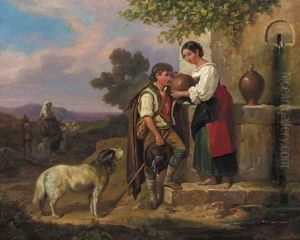Georg Ludwig Vogel Paintings
Georg Ludwig Vogel was a Swiss painter born on April 15, 1788, in Zürich, Switzerland. He was primarily known for his landscape paintings, which were pivotal in the early development of Swiss landscape art. His work often reflected a romantic sensibility, characterized by a meticulous observation of nature and a delicate rendering of light and atmosphere.
Vogel studied at the Academy of Fine Arts in Vienna beginning in 1808, where he was influenced by the works of the Dutch landscape painters of the 17th century. In 1810, he continued his studies in Paris, where he came into contact with the work of the French landscape painters of his time, which further affected the style and composition of his own pieces.
After his studies, he returned to Switzerland and traveled extensively through the Swiss Alps. These travels deeply influenced his artistic work, and he became one of the first artists to portray the Swiss landscape with a romantic eye, capturing the grandeur and majesty of the mountains. Vogel's landscapes were characterized by a sense of harmony and were often infused with a tranquil, idyllic quality.
During his lifetime, Vogel’s work was well-received, and he participated in numerous exhibitions. He was also a member of various art societies, which helped to establish his reputation as a leading landscape painter in Switzerland. Despite his success, Vogel remained dedicated to his art rather than seeking fame or fortune, and he continued to paint until his later years.
Georg Ludwig Vogel passed away on October 21, 1879, in Zürich. His legacy is preserved in the collections of various Swiss museums, and his influence can be seen in the work of subsequent generations of Swiss artists. Vogel's commitment to capturing the essence of the Swiss landscape set a standard for the naturalistic and romantic portrayal of nature in Swiss art that resonated throughout the 19th century and beyond.
